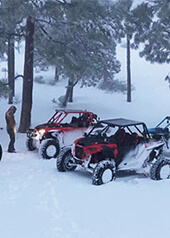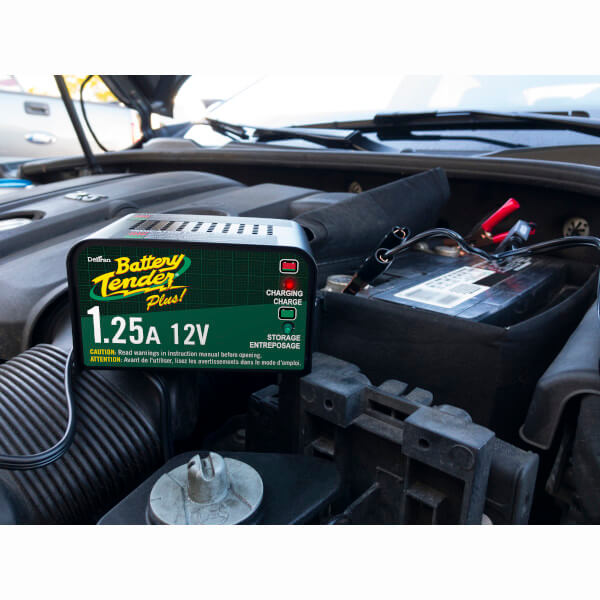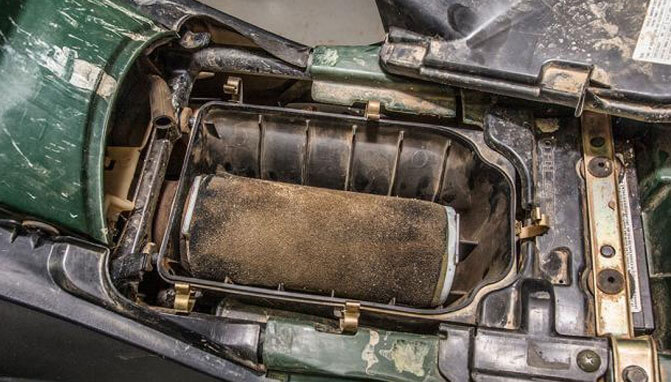
Winter riding means you can’t slack on repairs and general maintenance
The weather has been frozen in time it seems for the last few months and riding off-road gets to be even farther from your mind. That is until that one buddy rings your digits and then it is time to get the gear on and head out to the shed to start up old faithful for a day of fun. That is also when the more depressing realizations begin to set in as you have neglected the beast way too long and it has settled into a winter hibernation. ATV maintenance is serious business if you ride in the winter.
So how do you keep your ATV from becoming as useless as a straw in rock soup? There are many things to consider when preparing your machine for the winter riding months, but these six tips for winter ATV maintenance might just keep your choice rig free to ride at any time you are ready.
1: Take Care of Your Fuel
Never underestimate the capability of water to get in places it shouldn’t. Using gas from a fuel can that might have been sitting for months in the shop is a surefire way to incorporate H20 into the fuel system of your machine. Condensation from the simple changes of the climate in the shop or even outside in the open can introduce water into the gas tank. You might also get water in the fuel at your local fuel station if they are not cautious about monitoring the tanks. One way to prevent this type of tragedy is to simply look into the jug each time before use as the water will settle to the bottom. Also, never turn the fuel can all the way up as it empties but stop fueling right before the jug is empty and take a peep inside. There might be dirt or debris in that last cup of fuel so be cautious.
2: Use a Lightweight Oil During Winter Months
The oil in your ATV engine is the life blood of the machine. Keeping it changed goes without saying and important steps to not only extending the life of the machine but making it perform at its peak is the result. Oil can be crucial in changing climates as well. In the summer months when the temperatures soar, oil becomes thin and starts to lose its lubricity. This is why many manufacturers will advise you to use a 10-40w over the factory installed 10-30w during the hottest months. The thicker viscosity gives the oil better lubrication ability as your machine heats up. However, during the winter months the oil needs to be able to flow well as the rapid cooling and numbing temperatures keep the oil in a more consistent range. This is where a light weight synthetic oil would be a good option for those extreme climates.
3: Maintain Your Battery
A cold winter battery is pretty useless if the charge isn’t helped along by a battery charger. Starting an ATV on a cold winter day isn’t very tough for those who live in the southern states, but when you start heading north into the temperatures that dive into the teens it can become a real problem. Batteries will also begin to degrade over time and a good cold snap can finish them off. Our advice would be to connect the battery to a simple charger while being stored during the winter or even when it is stored during regular use. Making sure your battery is topped up and ready to go is a key part of ATV maintenance.
4: Wash Your ATV After You Ride
Cleanliness is key to a long life for your machine. If you ride in the really cold weather, dunk the poor beast into the deep snow, mud or ice then you will eventually have a build-up of “stuff” all over your rig. Now I know you’ll say, “well how do you clean an ATV in the winter?” I’m not sure how to answer that other than to say to be very aware of the type of slop you are riding in. It is fun, but if it all gets piled up onto the framework and sits for weeks before the next ride, the moisture and mud are very tough on bearings, boots and the steel that forms the frame work. If you know of a heated water car wash, take advantage of that place before you head home. ATV maintenance should start with a clean machine.
5: A Clean Air Filter is Essential
Animals like warm, closed spaces to live in winter and with a big castle like an airbox on an ATV you could have issues with squatters. One way to prevent the move in is to set traps, but another preventative measure is to simply check the airbox before you ride – something that should be a regular part of any ATV maintenance schedule. Make sure the air filter is cleaned regularly and the seal for the air filter to the box is coated with a little waterproof grease. This keeps the air flowing through the filter and not sneaking in around it. Another reason a clean air filter is necessary is that starting your ATV in the winter is already tough enough. Too much restriction and multiple turns of the engine can also act as a choke, flooding the motor with fuel. This creates yet another issue that some might never notice. Your ATV needs to breath easily and this just makes it run the best it possibly can.
6: Check Your Coolant
One example of why a clean machine is a better running machine is the radiator. Although getting an ATV warm in the winter can be tough, an ATV that overheats because it cannot properly cool itself is a worse issue. When we mentioned cleaning above, it goes without saying that the radiator should be part of that to prevent mud from blocking the radiator. There is also another item for winter riding that is just as important and that is the coolant in your radiator. Be sure to check the coolant for effective range and change it at least every two years if you store your machine during the winter months as part of your ATV maintenance schedule. Never run straight water in your cooling system, especially in areas where the temps are always near or below freezing.
*Originally written by Rick Sosebee for ATV.com. See original article here.



